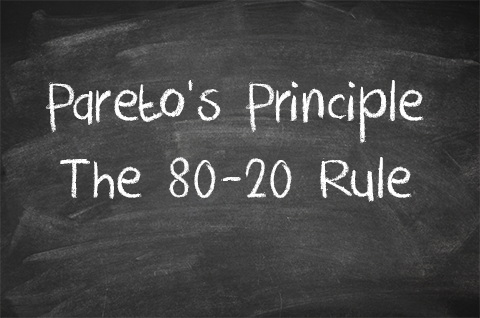
|
|
| Pareto Principle - The 80-20 Rule | |
|
|
|

What 20 Percent of your efforts are generating 80 percent of your results? Invest in the things that provide the largest return... The observations in the early 1900's of Italian economist Vilfredo Pareto laid the groundwork for what’s known today as the Pareto Principle. Pareto created a mathematical formula describing the unequal distribution of wealth he observed and measured in his country: he observed that roughly twenty percent of the people controlled or owned eighty percent of the wealth. An avid gardener, he also noticed that 80 percent of the yield of his pea crop came from 20 percent of the pea pods. He then noticed that the same ratio appeared in the distribution of land in Italy, where 80 percent of it was owned by 20 percent of the population. He observed that this was a pattern in many other situations as well. In 1937, Dr. Juran, Quality Management pioneer, applied Pareto’s observations about economics to a broader body of work. As a result, Dr. Juran’s observation of the “vital few and trivial many,” the principle that 80 percent of the effects come from 20 percent of the causes, became known as Pareto’s Principle or the 80–20 Rule. The impact of this rule can have large consequences for businesses and help leaders identify where they should focus their energy and their money—on the 20 percent that can have the most impact. You can apply the 80–20 rule to your life and your career:
In fact, we can take it further:
When we look at it this way, it seems obvious that most of the effects (80 percent) come from the smallest number (20 percent) of causes. The lesson here is for you to stop wasting precious time and resources on endeavors that drain money, energy, and time. Invest in the things that provide the largest return. The key is in how you evaluate the questions you might ask yourself such as:
“Pareto Thinking” (use of the Pareto Principle) should become a way of life for you. Your ability to separate the essential from the nonessential will improve with practice. This practice should initially involve the use of actual data rather than just “eye-balling” a situation. Once established, this approach will become a normal reaction to solving problems. In time, an experienced “Pareto Thinker” can even make quick, accurate judgment calls.
|
|||||||
|
|
| Visit: Exam Preparation | Continuing Education | Code Products | Newsletters | and more | |||
|
|
|||||||||||||
